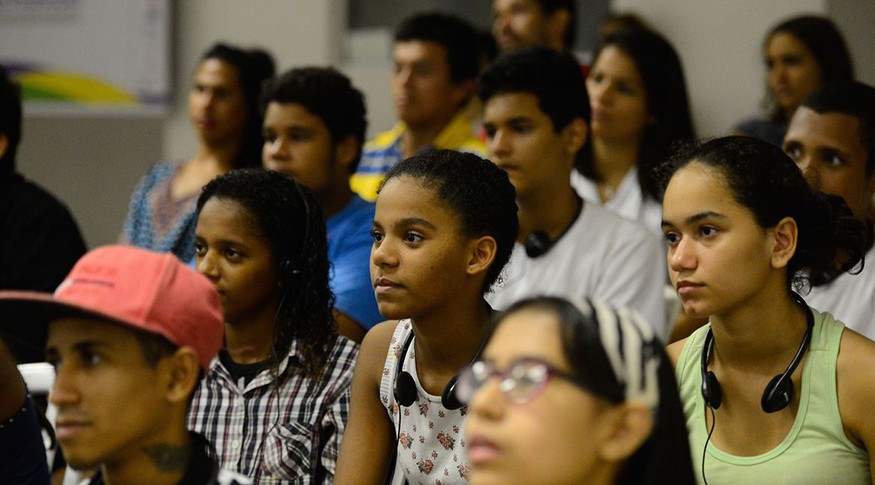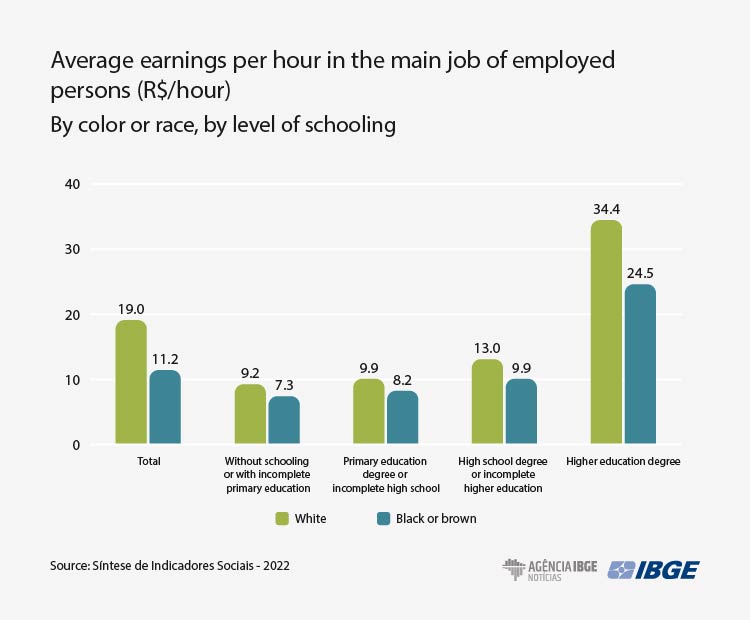Summary of Social Indicators
In 2021, 12.7 million youth in Brazil were neither stuyding nor working
December 02, 2022 10h00 AM | Last Updated: December 26, 2022 10h45 PM
Highlights
- The number of young people aged 15 to 29 who were neither studying or working in 2021 amounted to 12.7 million, that is, 25.8% of this age group.
- Maranhão had the highest percentage of youth in these conditons, 37.7% and Santa Catarina, the lowest, 12.5%.
- Among OECD member countries and partners, Brazil was number three in the ranking of young adults not studying or working in 2020.
- Employment population-ratio up from 51.0% in 2020 to 52.1% in 2021, but it is still below 2019 (56.4%).
- The compound underutilization rate remained high between 2020 and 2021 and hit the peak in the series: 28.5%.
- Unemployment among the young fell from 24.1% to 23.9% between 2020 and 2021, but it is still the highest among the age groups.

In spite of the decrease from 2020, first year of the pandemic, the number of youth not studying or working was 12.7 million in 2021, which corresponds to 25.8% of the persons aged 15 to 29. A total of 41.9% were black or brown women, 24.3% were black or brown men, 20.5% were white women and 12.5%, white men. These data can be found in the Summary of Social Indicators, released today (02) by the IBGE.
The IBGE indicator encompasses, simultaneously, youth who were not studying and were unemployed (looking for a job and available to work) and those who were not studying and were out of the workforce, that is, who took no action to find a job or did not find available positions. This indicator is, therefore, a more strict measure of youth vulnerability than the unemployment rate, because it encompasses those who were not acquiring work experience or qualification, possibly damaging their future employment possibilities.
It is worth mentioning that the annual education module of Continuous PNAD did not go out in the field in 2020 and 2021. In this respect, the condition as a student that forms the indicator of this release does not include some aspects of youth qualification, such as attendance to high school technical courses, teaching qualification courses, prep school and professional qualification courses (for a specific occupation).
“In the first year of the pandemic, there was a decrease in the group of employed youth and the increase in the percentage of students who only studied did not compensate for that drop. Nevertheless, there was an increase in the number of youth not studying or working. In spite of the slight recovery observed in 2021, this continuous condition remains affecting more than 1/4 of the youth aged 15 to 29,” Betina Fresneda, IBGE analyst, explains.

In the states of the North and Northeast (except Rondônia), the percentage of youth aged 15 to 29 who were not studying or working was above the national average (25.8%). The states in the South, Southeast and Central West (except Rio de Janeiro) were below the average.
The biggest percentages of youth not studying or working were found in Maranhão (37.7%) and Alagoas (36.6%) and the smalles, in Santa Catarina (12.2%) and Paraná (17.9%).
Among OECD countries, Brazil had the third biggest percentage of youth who were not studying or working in 2020/strong>
An analysis of the age group 18-24, a stratum compared to other OECD member countries and partners, evidences that, in 2020, not being studying or working became the most common status among young adults in Brazil. The percentage of youths who were neither studying nor working went from 29.3% in 2019, to 34.1% in 2020, having exceeded the percentage of young adults in any other employment consition. In 2021, the percentage of youths aged 18 to 24 who were not studying or working remained high, at 31.1%.
These results differ from those released for most countries listed in the publication Education at a glance de 2021. Youth got to spend the first year of the pandemic only studying. Exceptions were found in some countries such as Brazil, Colombia, Canada and the United States, which recorded significant increases in the number of these youths. Besides, in comparison with all the OECD member countries and partners, only South Africa and Colombia had a percentage of young adults not studying or working above that of Brazil in 2020.
“In 2020, OECD countries succeeded in ease this unfavorable situation in the labor market, with some exceptions: Brazil, Colombia, Canada and the United States. For that reason, this year, which was the toughest in terms of labor market, not being studying or working, in the case of this group of young adults, became the most frewuent condition of these youths, more than 1/3 of this population,” Ms. Fresneda analyzes.
In 2021, employment population ratio increased, but it is still lower than in preceding years
Employment population-ration changed from 51.0% in 2020 to 52.1% in 2021. In spite of this increase, the indicator remains below 2019 (56.4%) and, also, far from the peal of the series (58.1%), observed in 2012 and in 2014. The employment population ratio of women fell in 2020 and recovered more slowly in 2021, having expanded the difference between men and women. The employment population ratio of men in the period 2019-2021 decreased by 3.7 percentage points and reached 63.1%; for women, the decrease was of 4.8 percentage points, and reached 41.9% in 2021.
“The employment population ratio fell against 2020, but remains below the figure in preceding years. Also, women’s employment fell more than in 2020 versus that of men and recovered more slowly in 2021, having expanded this difference between the sexes,” says João Hallak, manager of the survey.
In 2021, the white employed population earned more per hour tha blacks and browns, for whatever level of schooling. The diffrence was observed in the category Higher education, R$ 36.70 versus R$ 26.00, that is, 40.8% more. Considering the average total figure, the difference was 69.0% in favor of the white population.

Underutilization rate reached the highest figure in the series in 2021
The compound underutilization rate encompasses three components: unemployment, time-related underemployment and potential workforce, which includes persons who were not employed, but had taken some effective action to find a job, but were not available to work or had not searched for work in spite of wanting and being available to work.
In the 2012-2021 series, the lowest rate was observed in 2014, 15.9%. As a result of the economic crisis in the end of 2014 and in the beginning of 2015, the rate rose from that year on, having remained in this path until 2018, when it reached 24.7%. In 2020, it rose again, and reached a new level, 28.3%, reaching the highest figure in the series in 2021, 28.5%.
Therefore, the job crisis triggered by the start of the Covid-19 pandemic made even more serious the underutilization status of the Brazilian workforce. A taxa se revelou mais elevada para mulheres e para as pessoas de cor ou raça preta ou perda. In 2021, 35.4% of the women and 33.2% of the black and brown persons were underutilized.
“Between 2012 and 2014 there was a decrease in the underutilization rate, but, from 2015 on, following a labor market trend, it has been increasing, having grown by 10.2 percentage points up to 2021. In absolute figuress, a total of 19.4 million persons were underutilized in 2015 and 32.6.6 million in results observed in 2021,” says Denise Guichard, analyst of the survey.




















